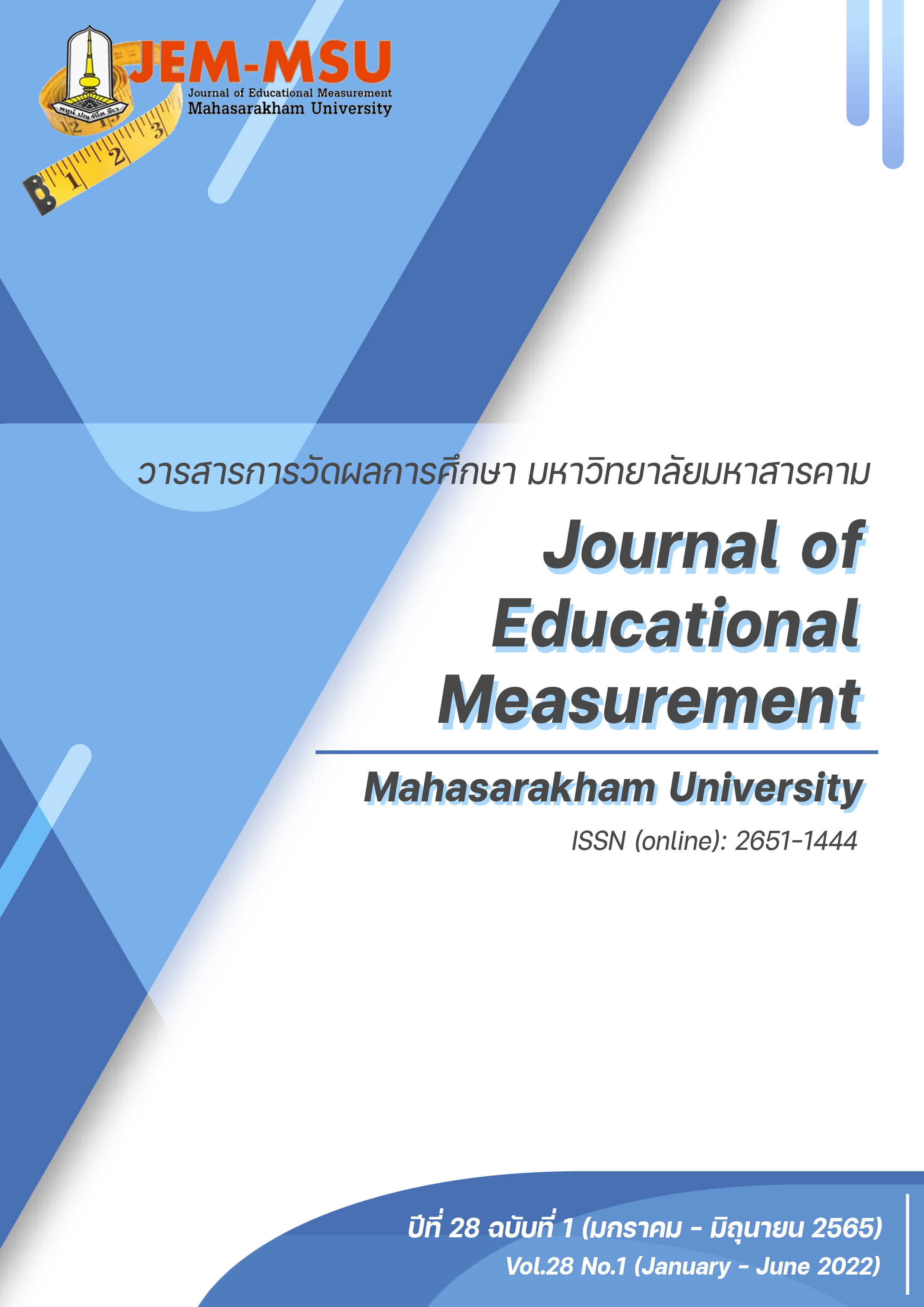Development of Assessment Tools for Learning Management in STEM Education
Main Article Content
Abstract
The research objectives were 1) to create and develop assessment tools for learning management in STEM Education, and 2) to find the relationships between each of the assessment tools for learning management in STEM Education. The research methodology was divided into two phases. The first phase dealt with creation of the assessment tools for learning management, using literature review and focus group discussion. The sample consisted of teachers, educational supervisors, experts in evaluation and educators, totaling 30, obtained through purposive sampling. The second phase dealt with trying out and implementing the assessment tools. The sample of the tryout stage consisted of 406 science and mathematics teachers in lower secondary schools and 9,697 students from 215 schools nationwide. The sample of the implementation stage comprised 272 teachers from the tryout stage and 6,238 students who were not in the tryout stage, from 144 schools nationwide. Both of the samples were obtained through cluster sampling. The statistics used to check the quality of the research tools were discrimination and Cronbach's alpha coefficient, and the Pearson product-moment correlation coefficient was used to find the relationships between them. The research results revealed that the assessment tools for learning management in STEM Education comprised 3 quantitative tools as follows: 1) the self-assessment form for learning management in STEM Education, 2) the students' perception assessment form for learning management in STEM Education, 3) UTOP class observation, and 4) 1 qualitative tool, which was the interview form for the teacher’s process of learning management. Regarding the quality of the research tools, the discrimination ranged from 0.28 to 0.66, the Cronbach's alpha coefficient ranged from 0.58 to 0.94. The relationships of UTOP and the self-assessment had the Pearson’s correlation coefficient ranging from .08 to .69, a low to moderate level of correlation. Also, the UTOP and the students' perception assessment had the Pearson’s correlation coefficient ranging from .11 to .89, a low to high correlation level, with statistical significance at the .05 level. Therefore, it can be concluded that the assessment tools which consisted of the self-assessment form, the students' perception assessment form, the interview form and the classroom observation could reflect authentic learning management in STEM Education and can be effectively applied to teacher and student development.
Article Details

This work is licensed under a Creative Commons Attribution-NonCommercial-NoDerivatives 4.0 International License.
The content and information contained in the published article in the Journal of Educational Measurement Mahasarakham University represent the opinions and responsibilities of the authors directly. The editorial board of the journal is not necessarily in agreement with or responsible for any of the content.
The articles, data, content, images, etc. that have been published in the Journal of Educational Measurement Mahasarakham University are copyrighted by the journal. If any individual or organization wishes to reproduce or perform any actions involving the entirety or any part of the content, they must obtain written permission from the Journal of Educational Measurement Mahasarakham University.
References
Beard, K. S., Hoy, W. K., & Hoy, A. W. (2010). Academic optimism of individual teachers: Confirming a new construct. Teaching and Teacher Education, 26, 1136-1144. http://doi:10.1016/j.tate.2010.02.003
Blazar, D., & Kraft M. A. (2017). Teacher and Teaching Effects on Students’ Attitudes and Behaviors. Educational Evaluation and Policy Analysis, 39(1), 146–170. http://doi: 10.3102/0162373716670260.
Goe, L., Bell, C. & Little, O. (2008). Approaches to Evaluating Teacher Effectiveness: A Research Synthesis. National Comprehensive Center for Teacher Quality.
King, Holly M. (2017). Teacher Affective Attitudes Inventory: Development and Validation of a Teacher Self-Assessment Instrument [Doctoral dissertation]. Antioch University http://aura.antioch.edu/etds/352 https://scholar.harvard.edu/files/mkraft/files/kraft_-_2019_-teacher_effects_jhr.pdf
Pianta, R. C., & Hamre, B. K. (2009). Conceptualization, measurement, and improvement of classroom processes: Standardized observation can leverage capacity. Educational Researcher, 38(2), 109–119. https://doi.org/10.3102/0013189X09332374
Reed, A. J. S. & Bergemann, V. E. (2001). A Guide to Observation, Participation, and Reflection in the Classroom. McGraw Hill.
UTeach Professional Development. (2014). UTeach Observation Protocol for Mathematics and Science. https://utop.uteach.utexas.edu/
Walkington, C. & Marder, M. (2018). Using the UTeach Observation Protocol (UTOP) to understand the quality of mathematics instruction. ZDM Mathematics Education. 50, 507–519. https://doi.org/10.1007/s11858-018-0923-7
Chalakbang, W. (2017). Mixed Methods Research. Nakhon Phanom University Journal, 7(2), 124-132. (in Thai)
Chulavatnatol, M. (2013). STEM Education Thailand and STEM Ambassador. IPST Magazine, 42(185), 14-18. (in Thai)
Ekakul, T. (2000). Research Methods in Behavioral and Social Science. Ubon Ratchathani Rajabhat Institute. (in Thai)
Jituea, N. & Pasunon, P. (2018). The use of tools to collect research data for education, the implementation of excellent schools. Veridian E-Journal, Silpakorn University, 11(2), 2118-2135. (in Thai)
Kanjanawasee, S. (2001). Traditional testing theory. Chulalongkorn University. (in Thai)
Kijkuakul, S. (2015). STEM Education. Journal of Education Naresuan University, 17(2), 201-207. https://so06.tci-thaijo.org/index.php/edujournal_nu/article/view/126628/165379
Klomim, K. (2016). Learning management based on stem education for student teachers. Journal of Education Naresuan University, 18(4), 334-348. https://so06.tci-thaijo.org/index.php/edujournal_nu/article/view/70988 (in Thai)
Office of the Basic Education Commission. (2015). Time Management Guide Moderate Class More Knowledge. Ministry of Education. (in Thai)
Panich, V. (2012). Graduate production in the 21st century. Suranaree Journal of Social Science, 6(2), 130-152. https://so05.tci-thaijo.org/index.php/sjss/article/view/20389/ 17707 (in Thai)
Punthai, B. (2016). Introduction to educational research methodology. Ramkhamhaeng University Press. (in Thai)
Sinthuwongsanont, M. (2006). The Supporting Factors of the Educational Management Affecting Students’ Quality in the Northeastern Part of Thailand. Journal of Education, 18(2), 115-118. (in Thai)
Siripatharachai, P. (2013). STEM Education and 21st Century Skills Development. Executive Journal, 33(2), 49-56. (in Thai)
Sourachai, T & Lileekpal, P. (2011). The Influence of the Improvement of Course Contents in ARC131 Architectural Drawing on Learning Outcome of ARC141 Materials and Construction (Bangkok) [Research Report]. Sripatum University. (in Thai)
Taweerat, P. (1997). Research methods in behavioral and social science (7th ed.). Office of Educational and Psychological Testing Srinakharinwirot University. (in Thai)
The Institute for the Promotion of Teaching Science and Technology (IPST). (2013). STEM Education Thailand and STEM Ambassadors, IPST Magazine, 42(185), 10-11. (in Thai)


